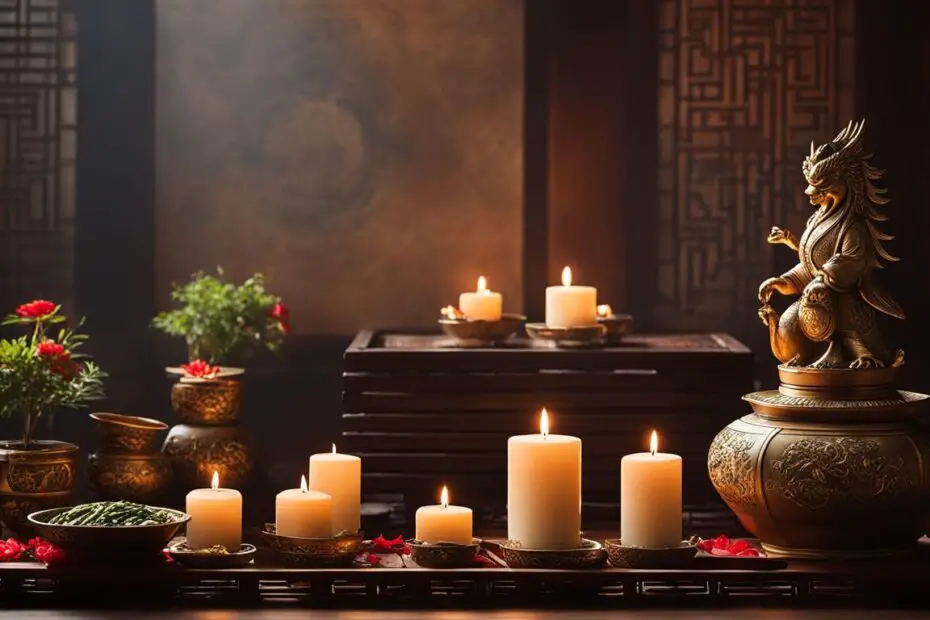Prayer plays a significant role in traditional Chinese culture, connecting individuals with ancient customs, rituals, and spiritual beliefs. In Chinese temples, picture-taking without permission is considered disrespectful towards the gods and the southern Chinese cultural religion. To enter a temple, one must have a sincere heart and offer tributes such as cooked chicken, fruits, pork, fish, rice cakes, and long thread moss algae.
The prayers are performed with incense, symbolizing good health, happiness, and success in various aspects of life. Lighting incense is done with the left hand, as the right hand was traditionally used for less pure activities. It is important to let the incense burn naturally, avoiding any signs of disrespect towards the gods. Other customs include the worship of ancestors, familial gatherings, and feasting on ancestral sacrifices after paying respects to the gods.
Key Takeaways:
- The rituals of prayer in traditional Chinese culture connect individuals with ancient customs and spiritual beliefs.
- Picture-taking without permission is considered disrespectful in Chinese temples.
- Prayers in Chinese culture are often performed with incense, symbolizing good health and success.
- Worship of ancestors and familial gatherings are important customs in Chinese prayer traditions.
- Feasting on ancestral sacrifices is a common practice after paying respects to the gods.
The Significance of Ancestor Worship in Chinese Prayer Traditions
Ancestor worship holds a significant place in Chinese prayer traditions, serving as a means of connecting with ancestral spirits and seeking their guidance and protection. It is believed that ancestors have transformed into godly beings, acting as a link to the supreme power of Tian. Family members come together in ancestral shrines to pay their respects and honor their lineage.
The rituals involved in ancestor worship include bowing or kneeling before the ancestral tablets, pouring white wine, and offering food. These acts express gratitude to the ancestors and seek blessings for the living. During these ceremonies, traditional prayers in Mandarin Chinese are recited, emphasizing the deep-rooted cultural significance of language in Chinese prayer practices.
“Our ancestors hold the key to our past and serve as our guiding lights in the present. Through ancestor worship, we acknowledge their wisdom and seek their blessings for a prosperous future.”
Ancestor worship not only reinforces the importance of family lineage but also promotes the concept of filial piety, which is deeply ingrained in Chinese culture. It serves as a reminder of the responsibility to honor and care for one’s ancestors, ensuring their continued presence and influence in the lives of their descendants.
By paying homage to their ancestors, the Chinese people maintain a strong connection to their cultural heritage and ancestral roots, fostering a sense of identity and belonging within the community.
The Role of Ancestors in Chinese Society
In Chinese society, ancestors hold a revered position and are considered important intermediaries between the living and the divine. They are believed to possess wisdom and spiritual power, offering guidance and protection to their descendants. Ancestor worship serves as a way to honor and uphold the memory of these ancestors, ensuring their continued presence within the family and community.
| Ancestor Worship Practices | Meaning |
|---|---|
| Bowing or kneeling | Show respect and submission to ancestors |
| Pouring white wine | Symbolizes sharing a drink with ancestors |
| Offering food | Express gratitude and provide sustenance for ancestors |
| Reciting prayers in Mandarin Chinese | Seek blessings and guidance from ancestors |
Through ancestor worship, the Chinese people maintain a deep sense of familial connection and unity, upholding the values and traditions passed down through generations. This practice symbolizes the reverence and gratitude held towards their ancestors and affirms the bond between the living and the deceased.
As Chinese prayer traditions continue to evolve, the significance of ancestor worship remains steadfast, reminding individuals of their cultural heritage and the importance of honoring their roots.
The Role of Temples in Chinese Prayer Practices
Chinese temples play a vital role in the practice of prayer, serving as sacred spaces where individuals can connect with the divine, seek blessings, and participate in religious rituals. These temples have specific rules and customs that visitors must adhere to, ensuring a respectful and sincere atmosphere for prayer.
One common practice in Chinese temples is the lighting of incense. Lighting incense symbolizes good health, happiness, and success in various aspects of life. It is important for visitors to hold the incense with their left hand as a sign of respect. Letting the incense burn naturally without extinguishing it prematurely is crucial to avoid any signs of disrespect towards the gods.
Prayer rituals in Chinese culture may vary among different families and regions. While some may choose to bow or kneel, others may pour wine as an offering. The length of the line of wine poured on the ground is believed to foretell the person’s lifespan. After visiting the temple, it is common for families to gather and pay respects to their deceased relatives, followed by a feast where ancestral sacrifices are enjoyed.
The Importance of Sincerity and Respect in Chinese Temple Practices
In Chinese prayer practices, sincerity and respect are of utmost importance. Visitors must approach the temple with a sincere heart, offering tributes such as cooked chicken, fruits, pork, fish, rice cakes, and long thread moss algae. This act demonstrates reverence and gratitude towards the gods.
“The temple is a sacred space where we come to connect with the divine. It is important that we approach our prayers with sincerity and respect, honoring the rituals and customs that have been passed down through generations.” – Elder Lin, Chinese temple worshiper
The Continuing Significance of Ancient Chinese Prayer Practices
Chinese prayer practices have deep roots in ancient traditions and continue to hold cultural significance today. Temples serve as a tangible link to the past, connecting individuals with their heritage and spiritual beliefs. By participating in prayer rituals, individuals not only seek blessings for themselves but also pay homage to their ancestors and strengthen familial bonds.
| Key Elements of Chinese Temple Practices | Meaning |
|---|---|
| Incense Lighting | Symbolizes good health, happiness, and success |
| Diverse Prayer Rituals | Varies among families and regions, reflecting cultural diversity |
| Sincerity and Respect | Essential for establishing a connection with the divine |
| Family Gatherings | Opportunity to pay respects to ancestors and strengthen familial bonds |

The continued practice of ancient Chinese prayer rituals in temples serves as a testament to the importance of cultural preservation and spiritual connection. These practices allow individuals to cultivate a sense of harmony, gratitude, and reverence, fostering a deeper understanding of their cultural identity and heritage.
Various Forms of Worship in Traditional Chinese Culture
Traditional Chinese culture encompasses a rich tapestry of diverse worship practices that reflect the spiritual beliefs and customs of the Chinese people. From physical exercises to offerings, these various forms of worship highlight the deep-rooted traditions and cultural significance of prayer in Chinese culture.
One prominent form of worship in traditional Chinese culture is the practice of physical exercises, such as Wushu (gong fu), Tai chi chuan (taijiquan), and Qidong. These exercises not only promote physical well-being but also serve as a means of spiritual practice. With movements that imitate animals, these exercises are performed by people of all ages, emphasizing the harmonious balance between the mind, body, and spirit.
Quote: “Wushu is not just a sport; it is a tradition and an art form.” – Jet Li
In addition to physical exercises, the offering of prayers and tributes is a common form of worship in Chinese culture. These offerings are made during specific lunar days or at the beginning of each new year to show gratitude and seek blessings. The items offered can vary, but they often include food, incense, and other symbolic items that hold cultural significance.
It is important to note that worship practices may vary across different regions of China. While certain temples may be neglected and unvisited except on specific days, other areas may have a stronger focus on specific deities or religious figures. For instance, the worship of the “old man of the sky” (Jade Emperor) is prevalent in some regions, highlighting the diverse nature of Chinese prayer traditions and the unique customs that arise from different local beliefs.
| Form of Worship | Description |
|---|---|
| Physical Exercises (Wushu, Tai chi chuan, Qidong) | Imitate animal movements, promote physical and spiritual well-being |
| Offerings | Prayers and tributes made on specific lunar days or at the beginning of the new year |
| Regional Variations | Different regions may have unique worship customs and focus on specific deities or religious figures |
The various forms of worship in traditional Chinese culture reflect the deep reverence and connection to ancestral customs and spiritual beliefs. They serve as a means for individuals to seek blessings, express gratitude, and maintain a harmonious balance between the physical and spiritual realms.
Conclusion
Prayer in traditional Chinese culture is a deeply rooted tradition that holds immense cultural significance. It serves as a means to connect individuals with ancient customs, rituals, and spiritual beliefs, fostering a sense of respect, sincerity, and gratitude. The practice of traditional Chinese prayer encompasses a wide range of customs and practices that have been passed down through generations.
Ancestor worship is a vital aspect of Chinese prayer traditions, highlighting the importance of family lineage and filial piety. By paying respects and seeking guidance from ancestors, individuals establish a connection with the past and honor their heritage. Temples also play a central role in Chinese prayer practices, serving as sacred spaces where people can seek blessings, participate in rituals, and pay homage to the gods.
Traditional Chinese prayer takes various forms, from physical exercises like Wushu and Tai chi chuan to the offering of sacrifices on special lunar days or during the new year. These diverse practices reflect the rich and multifaceted nature of Chinese prayer traditions. Overall, prayer in traditional Chinese culture is a profound and multifaceted tradition that encompasses both individual and communal devotion.
FAQ
What is the significance of prayer in traditional Chinese culture?
Prayer plays a significant role in traditional Chinese culture, connecting individuals with ancient customs, rituals, and spiritual beliefs.
Is picture-taking allowed in Chinese temples?
Picture-taking without permission is considered disrespectful towards the gods and the southern Chinese cultural religion.
What are the customs and offerings involved in temple visits?
To enter a temple, one must have a sincere heart and offer tributes such as cooked chicken, fruits, pork, fish, rice cakes, and long thread moss algae.
How is incense used in Chinese prayer practices?
The prayers are performed with incense, symbolizing good health, happiness, and success in various aspects of life. Lighting incense is done with the left hand, as the right hand was traditionally used for less pure activities.
What is ancestor worship and how is it practiced in Chinese culture?
Ancestor worship is a significant aspect of Chinese prayer traditions. It is believed that ancestors have become godly beings and act as a means of connection to the supreme power of Tian. Family members gather in ancestral shrines to pay their respects and seek guidance and protection.
What role do temples play in Chinese prayer practices?
Temples hold a central role in Chinese prayer practices. People visit temples to pray to the gods, seek blessings, and participate in religious rituals.
What forms of worship are practiced in traditional Chinese culture?
Physical exercises such as Wushu (gong fu), Tai chi chuan (taijiquan), and Qidong are considered popular forms of spiritual practice. Additionally, offerings are made to gods during certain lunar days or at the beginning of each new year.
How does prayer reflect the cultural significance in Chinese tradition?
Prayer holds immense cultural significance in traditional Chinese culture, serving as a way to connect with ancient customs, rituals, and spiritual beliefs, emphasizing the importance of respect, sincerity, and gratitude.









